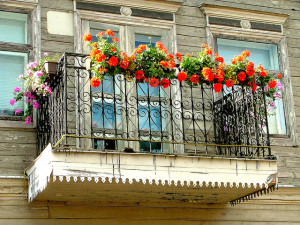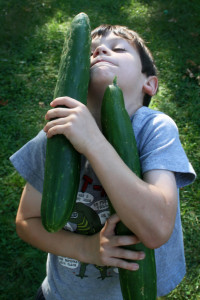 When it comes to planning a self-watering container garden, one of two things often happens: people either go overboard and cram every empty space they can find with containers only to realize they can’t walk around to them all, or they only start with one container holding a single plant and then are disappointed when all they get are a few green beans.
When it comes to planning a self-watering container garden, one of two things often happens: people either go overboard and cram every empty space they can find with containers only to realize they can’t walk around to them all, or they only start with one container holding a single plant and then are disappointed when all they get are a few green beans.
How big a self-watering container garden can be depends on a lot of things. Modeling for your concrete learner the kinds of thinking, reasoning, and planning that are necessary to sort it all out and build a productive but manageable garden goes a long way in laying the foundation for the more abstract kinds of thinking that will come later in his/her development.
By giving your learner a tangible example in the form of a self-watering container garden to see how well your plans play out and how to resolve problems when they develop, you harness the power of his/her concrete thinking while simultaneously doing the groundwork for what will come later for them, developmentally. A family container garden can foster many different key concepts that your learner must master during the concrete operations stage.
Calculating the area of your space may be something wise for you to do as an adult as you plan your self-watering container garden. Bear in mind, however, that for the purpose of this lesson, which is directed to kindergarten and early elementary aged children and others with similar learning profiles, calculating the area of your space is not going to be part of this project.
 Instead, you need to be more literal. A single self-watering container occupies approximately 1 square foot of space.
Instead, you need to be more literal. A single self-watering container occupies approximately 1 square foot of space.
To determine with your concrete learner how many containers can reasonably fit in your space with adequate room to walk around, including with loads of soil, hoses, fertilizer, etc., cut up a bunch of 1-foot-by-1-foot paper squares to account for the maximum number of containers you think your space will hold. Then go through your space with your learner and the stack of paper squares, placing a square wherever a container might go, arranging the squares to create trails and access points until you have a semi-final layout. If you run out of paper squares, just cut more.
The next step is to examine how light moves across your space throughout the day. This will take some data collection between you and your concrete learner over the course of one day (you can repeat the process once per month as your garden progresses, as well, as the path of light will change with the passage of the seasons). You may find that some locations where you had put down paper squares do not get enough light at all, in which case you do not need to put containers in those locations. Your container count decreases by the number eliminated from your plan by poor lighting.
It helps for your concrete learner to see where light falls and doesn’t on the paper squares throughout the day because this makes the concept concretely observable. That way, when you eliminate any squares from your garden design due to lack of light, your concrete learner understands why.
Probably one of the easiest ways to track the movement of light across your space is to pick a designated vantage point where you can capture the entire area with your camera once every hour throughout the daylight hours of the day. That way, you keep a record of the movement of the light that is organized by the date and time each picture was taken that you can use to plan which plants will go into the containers at which locations in order to maximize your light.
 The good news is that, if you realize that one spot is sunnier than another as time goes on, all you have to do is move your containers around. This is an absolute perk to container gardening. Had you planted in the ground only to realize there was better light in a different area afterwards, you wouldn’t be able to move your plants.
The good news is that, if you realize that one spot is sunnier than another as time goes on, all you have to do is move your containers around. This is an absolute perk to container gardening. Had you planted in the ground only to realize there was better light in a different area afterwards, you wouldn’t be able to move your plants.
The general rule is that if you are growing a plant for its fruit or its root, it needs full sun at least 6 hours a day, but if you’re growing a plant for its leaves or its seeds, it can handle partial shade. Being beat down on by the hot blazing sun for 6 straight hours can burn leaves and kill plants, even those that generally love sun. It is not necessary for plants that need direct light to be in 6 consecutive hours of direct sun per day; a little shade off and on throughout the day gives the plants a little reprieve and can help keep them lush. Too much shade, though, can cause them to fail to thrive and become spindly. You may be left to judging the behavior of your plants as they grow and rearranging containers now and then to accommodate for each container’s lighting needs.
 Just work with your concrete learner to understand the advantages and limitations of your available space with respect to lighting as well as the ability to get around the garden to tend to it with supplies. You may find that when you account for dark spots and tight corners, you can’t fit in as many containers as you would have liked. If you have more space available than what you are willing to spend the time filling and tending, then pick the most advantages locations for the number of containers you believe you have time to support.
Just work with your concrete learner to understand the advantages and limitations of your available space with respect to lighting as well as the ability to get around the garden to tend to it with supplies. You may find that when you account for dark spots and tight corners, you can’t fit in as many containers as you would have liked. If you have more space available than what you are willing to spend the time filling and tending, then pick the most advantages locations for the number of containers you believe you have time to support.
Because they are self-watering and are so conservative with water, watering the containers is rarely an issue. Depending on your climate and the types of plants you are growing, it could take months before you need to refill the reservoirs of your self-watering bucket containers.
The ongoing maintenance you will mostly need to provide will be more in the form of pest control, fertilizing, cleaning out debris that blows into your containers with the wind and/or fallen leaves, staking tall plants to keep them from falling over, pruning any plants that call for it (such as tomatoes), training anything vining (like cucumbers) to trellises, and cleaning up around the general garden area to keep walkways clear and safe.
If you intend to use your self-watering container garden as an ongoing learning opportunity for your concrete learner, then ongoing maintenance of the garden should be part of that experience. By tending to the garden over time, your concrete learner sees the process physically unfold before his/her eyes at such a gradual rate that his/her conceptualization of it becomes a perfectly natural act. That conceptualization can then serve as the springboard for other conceptualizations pertaining to the life sciences as he/she becomes more sophisticated in his/her learning.
You may need to occasionally point out the really cool stuff, however, to engage his/her interest. Do not presume that he/she will automatically notice or appreciate the cool stuff without you pointing it out and making a big deal about it. This could look like, “Oh my goodness! Did you see the ladybugs eating the aphids on your cabbage plants?” or “Wow! The compost you added to the soil really made these plants take off! Look how bigger and greener they are than the plants that didn’t get any compost, yet.”
With respect to determining how big your garden can be, look not only at the physical capacity of your space, but also lighting and how much work it will take to maintain gardens of different sizes. Look also at what your food production goals are for your garden.
 If you are seriously trying to relieve yourself of a grocery expense by growing as much of your own vegetables as possible, realize that limited space may force you into growing set seasonal crops rather than having lots of different things at once in your garden. You can get a serving of green beans large enough to serve a family of four for one to four nights, depending on growing conditions, from about five containers worth of green bean plants. Green beans grow and produce quickly, so you could conceivably grow several crops in a row or stagger two crops so that you always have some coming in throughout the growing season.
If you are seriously trying to relieve yourself of a grocery expense by growing as much of your own vegetables as possible, realize that limited space may force you into growing set seasonal crops rather than having lots of different things at once in your garden. You can get a serving of green beans large enough to serve a family of four for one to four nights, depending on growing conditions, from about five containers worth of green bean plants. Green beans grow and produce quickly, so you could conceivably grow several crops in a row or stagger two crops so that you always have some coming in throughout the growing season.
Other plants take months to a year to come to bear, which means that you’re not going to eat anything from your garden anytime soon if those are the only kinds of plants you grow. Carrots do particularly well, as do beets. You can eat the greens of the beets in salads. In fact, as you have to thin out baby carrots to make room for their neighbors to grow, and prune your other plants, you can steal a leaf or two from growing beets for your salads and they’ll simply grow more leaves.
Just be careful not to take too many at once as the beet plants need their leaves to absorb light and grow. By taking the lowest leaves from beets as they mature, you prevent old, scraggly, rotten leaves from collecting around their bases. You also allow the plant to invest more in its edible root than maintaining a big head of foliage. Include them with the baby carrots in your salads.
Figuring out what you intend to grow factors into how much time you will spend working in your garden. Some plants require less maintenance than others. Tomatoes can require constant pruning, particularly if they are reluctant to flower. Thinning beets and carrots as they come in takes some time. If you have a single container of carrots, it’s not so bad. If you have seven containers of carrots, you could be at it for a while.
A lot of what will end up working for your family will be discovered through trial and error. Given the low cost of self-watering container gardening, it’s worth it to play around with different types of plants and see what works for your situation. If something fails to thrive and dies, pull it up, fold compost or fertilizer into the soil to prep it for another planting, and try something else. Baby plants are inexpensive and seeds cost even less. You can recycle the container and its soil from growing season to growing season, rotating crops and dosing it with compost or fertilizer to keep the soil viable, changing nothing but the plants.
If you still ending up biting off more than you can chew, you can always give away a planted self-watering bucket container as a gift to someone else who would enjoy it. Grandparents, neighbors, caregivers, and family friends are all possible recipients of gifted self-watering bucket containers. Who knows? Maybe you can inspire someone else to start his/her own self-watering container garden.
Consider also the knowledge your learner stands to share with peers during social gatherings in your garden. A self-watering container garden can create socialization opportunities for concrete learners, which can also be structured by professionals for individuals struggling to acquire pragmatic/social language skills, such as some children and adults with autism, making it a perfect teaching vehicle for many types of home-based Applied Behavioral Analysis (ABA) programs.
Sharing your garden with his/her peers allows your learner to become what child development researcher Lev Vygotsky (1896-1934) referred to as “a more competent other” and a trusted ally to his/her peers in the sharing of knowledge. It can give your learner a sense ownership of the outcome of the garden and foster leadership skills, both of which are valuable concepts throughout one’s lifetime.
Be sure in planning your garden space to account for groups of individuals who are interested in your and your learner’s garden. Knowledge powers solutions, so help your learner share it with others and you foster his/her sense of contributing to the community, as well.
